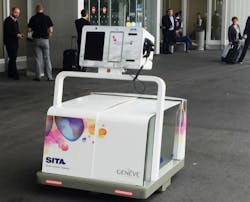Baggage-Checking Robot Allows Passengers to Skip Check-In Lines
A baggage-checking robot, with the capacity to check-in, print bag tags and transport up to two suitcases at a time, made its first trial debut.
SITA, an air transport communications and information technology company, unveiled the development of the fully autonomous, self-propelling baggage robot, known as Leo, outside Geneva Airport's Terminal 1.
Leo uses artificial intelligence to collect bags from passengers, check them in, transport them and load them onto the correct flight, allowing passengers to skip the baggage check lines entirely.
"Through the innovative work of the SITA Lab we are able to tackle some of the key challenges that face airports today," SITA President Europe Dave Bakker said in a news release. "Leo demonstrates that robotics hold the key to more effective, secure and smarter baggage handling and is major step towards further automating bag handling in airports. Leo also provides some insight into the potential use of robots across the passenger journey in future.”
To use Leo, passengers place their bags, under 32kg, inside the compartment doors and scan their boarding pass. Then, tags are printed and passengers will place them on the bags. Once it is verified by Leo that all the bags are tagged and loaded, the compartment doors close and the boarding gate and departure time are displayed. The doors can not be opened again until Leo arrives at an unloading dock operator.
After the compartment doors are closed, the passengers role is over. Leo takes the bags directly to the baggage handling area to be sorted and connected to the correct flight.
"In a busy airport such as Geneva Airport, the use of a robot such as Leo limits the number of bags in the airport terminal, helping us accommodate a growing number of passengers without compromising the airport experience inside the terminal," Massimo Gentile, head of IT at Geneva Airport, said in a news release. "Leo also proves the case for increased use of robotics to make passengers’ journey a little more comfortable, whether it is checking in baggage, providing directions or helping them through the security process.”
SITA also recently delivered another innovation—a Windows 10 universal app to fully digitize the ground operation processes of departure control systems, flight information, roster and inventory management and third party services.
The app, SITA AirsideApp, is meant to replace the paper-based processes currently in place by integrating the airline, airport and ground handler systems used during ground operations.
"SITA and Microsoft have focused development on improving the workflow for ground staff at airports," Senior Vice President of SITA Communications and Infrastructure Dan Ebbinghaud said. "By moving from paper-based checklists and operations, SITA AirsideApp eliminates fragmented processes and enables workforce collaboration. This agile way of working means it is easier to make the right decision quickly every time.”
About the Author
Vesna Brajkovic
Vesna Brajkovic, who grew up around pilots and aviation mechanics, creates digital content for AviationPros.com. She recently graduated from the University of Wisconsin-Whitewater. When she's not writing about the aviation industry, you can find her freelancing for MyCommunityNow-Lake Country (USA Today Network). She can be reached at [email protected].
